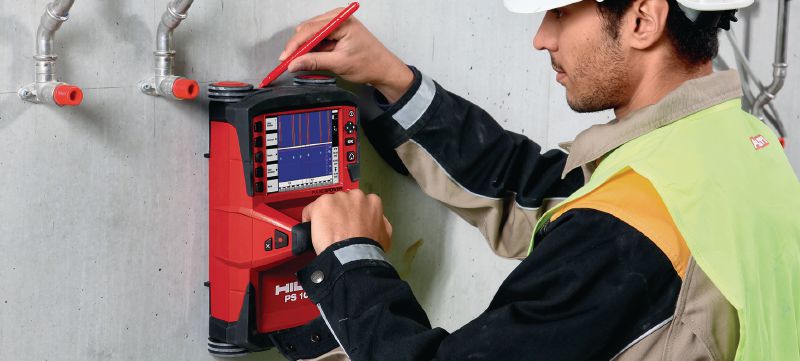Concrete Scanning: A Critical Action In The Direction Of Guaranteeing Structural Integrity and Safety And Security
In the realm of building and construction and infrastructure upkeep, the importance of concrete scanning can not be overemphasized. By employing sophisticated technology and methods, concrete scanning serves as an essential tool in making sure that the honesty and security of bridges and structures are upheld to the highest possible requirements.
Relevance of Concrete Scanning
Concrete scanning plays a crucial duty in guaranteeing the structural integrity and security of buildings and infrastructure tasks. By using innovative technologies such as ground-penetrating radar (GPR) and electro-magnetic induction, experts can non-destructively inspect concrete frameworks to find potential problems, gaps, embedded things, and reinforcement design. This process allows early detection of abnormalities that might compromise the security of a structure, stopping costly problems and making sure the safety and security of occupants.
Concrete scanning is especially crucial throughout the preparation and building and construction stages of a task. Prior to drilling, cutting, or coring right into concrete, scanning aids identify the precise locations of rebar, post-tension cable televisions, and other embedded elements, reducing the risk of accidental hits that could lead to structural weak points. In addition, concrete scanning aids in quality assurance by verifying the thickness of concrete covers and detecting any type of discrepancies that may influence the overall longevity of the structure. Eventually, purchasing concrete scanning solutions is not only a positive measure to mitigate threats yet also a fundamental step towards maintaining the long-term safety and security and stability of buildings and framework.
Innovation for Concrete Inspection

Benefits of Very Early Discovery
Timely detection of structural issues can substantially alleviate risks and guarantee the durability of building jobs. By determining prospective issues early in the building process, stakeholders can take positive procedures to attend to concerns prior to they rise right into bigger and a lot more pricey troubles. Among the vital advantages of early detection is the avoidance of architectural failings, which can pose major security dangers and lead to job delays and financial losses.
Moreover, very early detection enables for prompt fixings and maintenance, which can assist expand the lifespan of the structure. By resolving concerns immediately, building teams can stay clear of expensive repair work and even the demand for premature substitute of structural components. This aggressive method not only conserves time and money yet likewise enhances the total security and toughness of the building task.
Furthermore, very early detection can improve task preparation and decision-making by giving stakeholders with useful insights right into the condition of the structure. Equipped with this details, job managers his response can make enlightened selections pertaining to construction methods, materials, and timelines, resulting in more effective and efficient task results.
Ensuring Structural Security
Making sure the architectural stability of a building and construction job is extremely important to its safety and security and durability. Concrete scanning plays an essential function in making certain architectural security by spotting possible problems such as spaces, delamination, or reinforcement deterioration that can jeopardize the stability of the framework over time.
By using advanced scanning technologies like ground-penetrating radar (GPR) and electro-magnetic induction, building specialists can non-invasively examine concrete frameworks to identify areas of worry underneath the surface area. This positive method permits the early detection of defects or weak points, enabling timely repair services or support to stop structural failures.
Routine concrete scanning during different construction stages and throughout the life process of a structure can assist keep its security, alleviate threats, and guarantee the security of residents. By focusing news on architectural stability through concrete scanning, building and construction projects can improve their resilience and longevity, ultimately adding to greater security and longevity.
Avoiding Vital Failings
To guard against devastating events, precise tracking and aggressive maintenance are vital in preventing critical failures within architectural frameworks. Discovering possible issues prior to they escalate is crucial to stop structural failings. Implementing regular inspections, such as concrete scanning, can reveal covert flaws like spaces, fractures, or corrosion that might jeopardize the integrity of a framework. By using sophisticated scanning technologies like Ground Permeating Radar (GPR) or Concrete X-ray, engineers can non-destructively assess the problem of concrete and recognize weak points that require reinforcement or repair work - RainierGPR Service Areas.

Conclusion
Finally, concrete scanning plays a critical function in guaranteeing architectural honesty and safety and security by using sophisticated technology for very early detection of possible concerns. This aggressive technique helps stop vital failures and ensures the stability of frameworks. It is vital to prioritize concrete examination as a standard practice to protect the longevity and security of buildings and framework.
Concrete scanning plays a vital function in making sure the structural honesty and safety and security of structures and framework jobs. Additionally, concrete scanning help in high quality control by confirming the density of concrete covers and identifying any kind of discrepancies that might affect the general longevity of the framework. Concrete scanning plays a vital function in making wikipedia reference sure architectural security by detecting potential concerns such as gaps, delamination, or support deterioration that might compromise the integrity of the structure over time.
In conclusion, concrete scanning plays a vital duty in guaranteeing architectural integrity and safety by making use of innovative technology for early discovery of prospective concerns.